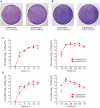Oseltamivir-resistant pandemic H1N1/2009 influenza virus possesses lower transmissibility and fitness in ferrets
- PMID: 20686654
- PMCID: PMC2912389
- DOI: 10.1371/journal.ppat.1001022
Oseltamivir-resistant pandemic H1N1/2009 influenza virus possesses lower transmissibility and fitness in ferrets
Abstract
The neuraminidase (NA) inhibitor oseltamivir offers an important immediate option for the control of influenza, and its clinical use has increased substantially during the recent H1N1 pandemic. In view of the high prevalence of oseltamivir-resistant seasonal H1N1 influenza viruses in 2007-2008, there is an urgent need to characterize the transmissibility and fitness of oseltamivir-resistant H1N1/2009 viruses, although resistant variants have been isolated at a low rate. Here we studied the transmissibility of a closely matched pair of pandemic H1N1/2009 clinical isolates, one oseltamivir-sensitive and one resistant, in the ferret model. The resistant H275Y mutant was derived from a patient on oseltamivir prophylaxis and was the first oseltamivir-resistant isolate of the pandemic virus. Full genome sequencing revealed that the pair of viruses differed only at NA amino acid position 275. We found that the oseltamivir-resistant H1N1/2009 virus was not transmitted efficiently in ferrets via respiratory droplets (0/2), while it retained efficient transmission via direct contact (2/2). The sensitive H1N1/2009 virus was efficiently transmitted via both routes (2/2 and 1/2, respectively). The wild-type H1N1/2009 and the resistant mutant appeared to cause a similar disease course in ferrets without apparent attenuation of clinical signs. We compared viral fitness within the host by co-infecting a ferret with oseltamivir-sensitive and -resistant H1N1/2009 viruses and found that the resistant virus showed less growth capability (fitness). The NA of the resistant virus showed reduced substrate-binding affinity and catalytic activity in vitro and delayed initial growth in MDCK and MDCK-SIAT1 cells. These findings may in part explain its less efficient transmission. The fact that the oseltamivir-resistant H1N1/2009 virus retained efficient transmission through direct contact underlines the necessity of continuous monitoring of drug resistance and characterization of possible evolving viral proteins during the pandemic.
Conflict of interest statement
While the study reported here did not utilize corporate funding, Drs. Elena A. Govorkova and Robert G. Webster are currently performing a different research study funded by F. Hoffmann-LaRoche, Ltd., Basel, Switzerland. The authors declare no competing financial interests.
Figures



Similar articles
-
Oseltamivir-resistant variants of the 2009 pandemic H1N1 influenza A virus are not attenuated in the guinea pig and ferret transmission models.J Virol. 2010 Nov;84(21):11219-26. doi: 10.1128/JVI.01424-10. Epub 2010 Aug 25. J Virol. 2010. PMID: 20739532 Free PMC article.
-
Comparable fitness and transmissibility between oseltamivir-resistant pandemic 2009 and seasonal H1N1 influenza viruses with the H275Y neuraminidase mutation.J Virol. 2012 Oct;86(19):10558-70. doi: 10.1128/JVI.00985-12. Epub 2012 Jul 18. J Virol. 2012. PMID: 22811535 Free PMC article.
-
An I436N substitution confers resistance of influenza A(H1N1)pdm09 viruses to multiple neuraminidase inhibitors without affecting viral fitness.J Gen Virol. 2018 Mar;99(3):292-302. doi: 10.1099/jgv.0.001029. J Gen Virol. 2018. PMID: 29493493
-
Consequences of resistance: in vitro fitness, in vivo infectivity, and transmissibility of oseltamivir-resistant influenza A viruses.Influenza Other Respir Viruses. 2013 Jan;7 Suppl 1(Suppl 1):50-7. doi: 10.1111/irv.12044. Influenza Other Respir Viruses. 2013. PMID: 23279897 Free PMC article. Review.
-
[Drug-resistant influenza viruses: an overview].Nihon Rinsho. 2010 Sep;68(9):1671-8. Nihon Rinsho. 2010. PMID: 20845746 Review. Japanese.
Cited by
-
Predicting Permissive Mutations That Improve the Fitness of A(H1N1)pdm09 Viruses Bearing the H275Y Neuraminidase Substitution.J Virol. 2022 Aug 10;96(15):e0091822. doi: 10.1128/jvi.00918-22. Epub 2022 Jul 14. J Virol. 2022. PMID: 35867563 Free PMC article.
-
Behaviours of antiviral Oseltamivir in different media: DFT and SQMFF calculations.J Mol Model. 2021 Nov 23;27(12):357. doi: 10.1007/s00894-021-04962-3. J Mol Model. 2021. PMID: 34812947 Free PMC article.
-
Impact of potential permissive neuraminidase mutations on viral fitness of the H275Y oseltamivir-resistant influenza A(H1N1)pdm09 virus in vitro, in mice and in ferrets.J Virol. 2014 Feb;88(3):1652-8. doi: 10.1128/JVI.02681-13. Epub 2013 Nov 20. J Virol. 2014. PMID: 24257597 Free PMC article.
-
Detection and management of antiviral resistance for influenza viruses.Influenza Other Respir Viruses. 2013 Nov;7 Suppl 3(Suppl 3):18-23. doi: 10.1111/irv.12176. Influenza Other Respir Viruses. 2013. PMID: 24215378 Free PMC article. Review.
-
Severity of clinical disease and pathology in ferrets experimentally infected with influenza viruses is influenced by inoculum volume.J Virol. 2014 Dec;88(23):13879-91. doi: 10.1128/JVI.02341-14. Epub 2014 Sep 3. J Virol. 2014. PMID: 25187553 Free PMC article.
References
-
- Dawood FS, Jain S, Finelli L, Shaw MW, Lindstrom S, et al. Emergence of a novel swine-origin influenza A (H1N1) virus in humans. N Engl J Med. 2009;360:2605–2615. - PubMed
-
- WHO. Situation updates - Pandemic (H1N1) 2009. 9 A.D. November. http://www.who.int/csr/disease/swineflu/updates/en/index.html.
-
- Deyde VM, Xu X, Bright RA, Shaw M, Smith CB, et al. Surveillance of resistance to adamantanes among influenza A(H3N2) and A(H1N1) viruses isolated worldwide. J Infect Dis. 2007;196:249–257. - PubMed
-
- Bright RA, Shay DK, Shu B, Cox NJ, Klimov AI. Adamantane resistance among influenza A viruses isolated early during the 2005–2006 influenza season in the United States. JAMA. 2006;295:891–894. - PubMed
Publication types
MeSH terms
Substances
Grants and funding
LinkOut - more resources
Full Text Sources
Other Literature Sources
Medical

